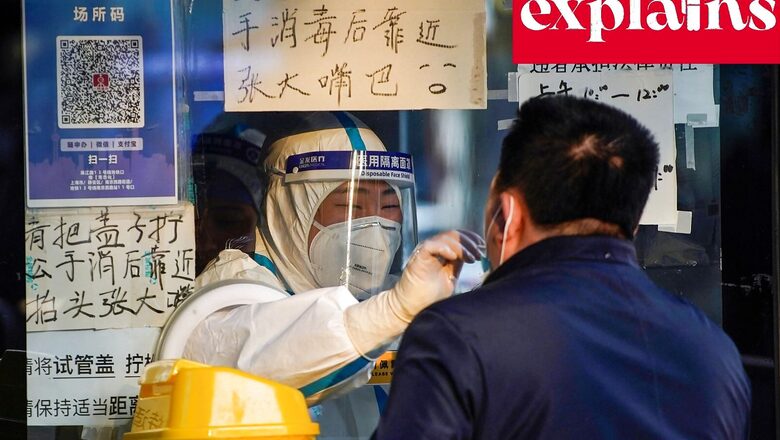
views
It was a long haul away from Zero Covid for China. But now that the country is opening up, the situation has worsened with increased cases and reported hospitalisations, deaths. Visuals of burdened health systems lend a horrific memory lane route to when India faced the dismal second wave, amid the emergence of the highly deadly variant of Covid-19 called Delta. But does our nation need to worry about the increase in infections in China now?
The answer is not so simple.
Reports said yesterday that amid the sudden spurt in Covid-19 cases in Japan, South Korea, Brazil, China and the US, the central government urged all states and Union territories to gear up the whole genome sequencing of positive samples to keep track of emerging variants.
In a letter to states and UTs, Union Health Secretary Rajesh Bhushan said such an exercise will enable timely detection of newer variants, if any, circulating in the country and will facilitate undertaking of requisite public health measures.
Today, Union Health Minister Mansukh Mandaviya will review the virus situation “considering the international scenario.”
Currently, India is recording around 1,200 cases on a weekly basis. However, the challenge of Covid-19 still persists around the world with around 35 lakh cases being reported weekly.
To understand whether India needs to be worried about a possible resurgence of Covid-19 cases, we will look at a number of factors:
What Variant is Spreading in China?
According to multiple news reports, the omicron subvariant BF.7 is to blame for the Covid breakout in China.
The omicron variant of Covid-19 has evolved into several subvariants since its appearance in 2021. A report by Live Science states that BF.7 is an abbreviation for BA.5.2.1.7, a sub-lineage of the omicron variant BA.5.
BF.7 is said to be the most infectious of the omicron subvariants, including BA.1 and BA.2.
According to Li Tongzeng, a medical expert at Beijing’s Xiaotangshan Hospital, it also has a higher immune escape capability. Immune escape is the inability of the host’s immune system to respond to an infectious agent.
Omicron BF.7 also has a shorter incubation period and a faster transmission rate.
Can This Variant Propel Cases in India?
Some experts say that they are not too worried.
This is because the few highly transmissible variants of Omicron spreading across China are not particularly unique.
India has been detecting these strains and data from India’s SARS CoV 2 genomic surveillance programme, or INSACOG. BF.7 has been present here for months.
There is Also the Factor of Immunity
China was relying on the Zero Covid approach all this while to deal with the pandemic.
In contrast to other countries, which have accepted that they will have to live with the disease to some extent, China was pursuing a policy known as “dynamic zero,” which entails taking dynamic action wherever Covid-19 flares up in order to eradicate it.
The Chinese government claimed that this policy saves lives because uncontrolled outbreaks endanger many vulnerable people, such as the elderly.
Due to strict lockdowns, China’s death toll has remained low since the outbreak began – the official figure is now just over 5,200.
This reported figure equates to three Covid deaths per million in China, compared to 3,000 in the United States and 2,400 in the United Kingdom, the BBC reported.
But due to this factor, a large majority of the Chinese population was never exposed to the virus like other countries, leading to low levels of immunity – because of low levels of infection so far.
After country-wide anti government and lockdown protests in China, Xi Jinping began relaxing lockdown, putting an end to Zero Covid.
However, as predicted, this has led to a spurt in infections and hospitalisations, and even reported deaths.
Compare this to India and one will understand that India has gone through multiple Covid-19 waves already, under various variants.
Our worst wave was in 2021 under the Delta waves, which saw the country struggling for oxygen and basic healthcare facilities. Later, we also experienced an Omicron wave, which was comparatively milder than the second wave.
“I do not see significant spillover impact on India,” Dr Anurag Agrawal, who has previously been associated with INSACOG closely as a director of the New Delhi-based Centre for Scientific and Industrial Research- Institute of Genomics and Integrative Biology (CSIR-IGIB) told Moneycontrol.
“Population immunity is much higher in India and our research suggests that most people have already been infected with Omicron, with a large fraction having had both Delta and Omicron infections,” said Agrawal.
Additional immunity provided by India’s large vaccination programme reduces the potential for major impact, he said, adding, “think of it this way, we have already paid the cost.”
The same sentiment was highlighted by NTAGI chief NK Arora.
NK Arora, the chairman of the COVID-19 working group of the National Technical Advisory Group on Immunization (NTAGI), said that there is nothing to panic about as the country’s system is “vigilant”.
“It is an important thing that we keep a close vigil on the Chinese situation. But I would say that there is nothing to be panicked about. There is no need for getting too much worried. The system is very vigilant, we need to be very vigilant. As far as genomic surveillance is concerned, this is the most important part we are doing genomic surveillance of individuals with symptoms,” he said, according to a report by Times Now.
Let’s Also Not Forget About India’s Vaccination Programme
After the deluge of the second wave, India really stepped up its vaccination measures.
Various types of vaccines were also given authorisation, in order to expand the programme and get as many people as possible inoculated. Even teens were vaccinated against Covid-19.
India has also started its booster programme, which however, has seen fewer takers than the two mandatory doses, say reports.
When it comes to China, the country’s vaccination rate is above 90%, but the rate for boostered adults drops to 57.9%, and to 42.3% for people aged 80 and above, according to government data.
In September, an article by a publication under the Chinese Center for Disease Control and Prevention (CDC) acknowledged coverage of older adults was poor, and that the absence of local doctors in vaccine drives, poor medical understanding and a lack of insurance for potential side effects all dampened enthusiasm.
“It’s a very special case in China because people felt very safe for a long time,” said Stephanie Jean-Tsang, an assistant professor at Hong Kong Baptist University who specialises in messaging around health.
Authorities have not made vaccination mandatory amid signs that the public would push back against any such move. Last week China said it would start to offer a second booster – or fourth shot – for high-risk groups and people over 60 years old.
Overseas-developed vaccines are unavailable in mainland China to the general public, which has relied on inactivated shots by Sinopharm, Sinovac’s Coronavac and other domestically developed options for its vaccine rollout and which the medical community has found to be safe. It has also yet to introduce its own version of an mRNA vaccine.
While China’s medical community in general doesn’t doubt the safety of China’s vaccines, questions remain over their efficacy compared to foreign-made mRNA counterparts, said Kelly Lei, a doctor in the southern Chinese city of Shenzhen.
In late November, the hashtag ‘Sinovac vaccine counterfeit’ surged to five million views on the Twitter-like Weibo platform, with many posts discussing lumps and hair loss allegedly caused by the locally made vaccine.
“At least a half of doctors and educated people wanted to get the mRNA ones and refused to get the Chinese ones,” Lei said.
“After a while, people see no hope and also they are kind of forced to get the Chinese ones, so they had to accept it. Some doctors talked to me, and said it’s useless anyway, why waste the money.”
Lei said many of her friends are looking to visit the neighbouring Chinese territory of Macau, where mainlanders can receive mRNA vaccines.
Demand has surged in recent weeks, visitors to Macau say, with the online booking platform for vaccination showing no bookings available until Jan. 21.
There is also the problem of vaccine hesitancy in China.
Early reluctance to get vaccinated was due to initial uncertainty about safety outcomes in older people, which stemmed in part from a lack of clinical trials assessing the outcomes of domestic vaccines in this age group.
In some cases, physicians who advised older patients with chronic conditions against vaccination shared this reluctance.
However, widespread scepticism about vaccines predates the Covid-19 pandemic, which has been fueled by scandals; in July 2018, the Chinese vaccine manufacturing company Changsheng Biotechnology was found to have falsified inspection data for a rabies vaccine and to have manufactured ineffective diphtheria, pertussis, and tetanus vaccines for children and infants, a report by Lancet states.
Because of the lack of trust in domestic vaccine development, many older people, who are already concerned about safety and often prefer traditional medicine, have refused Covid-19 vaccination.
But That’s No Reason to Not Take Precautions
All said and done, it is necessary to take precautions to prevent the spread of infection of the emergence of variants in India.
Despite herd and hybrid immunity, many risk groups remain vulnerable to Covid-19. And then there is the probability of long Covid as well, which causes the virus to remain within the body in a dormant form.
It is in these scenarios that newer variants of the virus emerge, because of the virus mutating through the replication process within the body.
So, mask up, get your boosters and take necessary social distancing measures in crowded places. Also use hand sanitisers wherever necessary.
With inputs from Reuters
Read all the Latest Explainers here

















Comments
0 comment